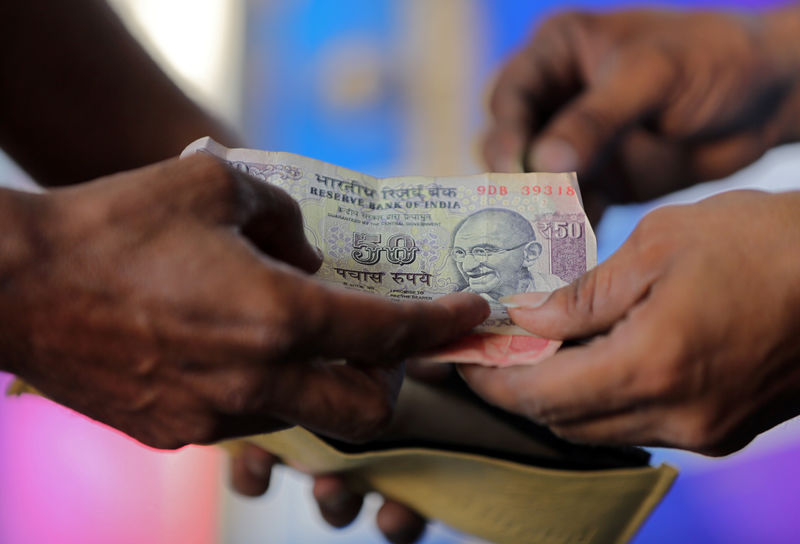 © Reuters. A customer hands a 50-Indian rupee note to an attendant at a fuel station in Ahmedabad
© Reuters. A customer hands a 50-Indian rupee note to an attendant at a fuel station in AhmedabadBy Shrutee Sarkar
BENGALURU (Reuters) – There will be little respite for the bruised Indian rupee over the coming year, depressed by an escalating U.S.-China trade war and rising domestic political risks ahead of a general election, a Reuters poll showed.
Investors have generally shunned emerging market assets this year, made riskier by the international trade tensions and the increasing attractiveness of dollar yields thanks to the U.S. Federal Reserve’s steady pace of rate increases.
That, and a widening current account deficit due to higher global prices and capital outflows, has pushed the rupee down almost 16 percent this year, regularly setting all-time lows. It’s one of the worst performing Asian currency this year.
“The Indian rupee reflects emerging market concerns and is facing significant depreciation pressure,” noted Tuuli McCully, head of Asia-Pacific economics at Scotiabank.
“In addition to the twin-deficit position, political uncertainty in India will remain high over the coming months due to four state elections that will be held by the end of January 2019, followed by general elections in April–May 2019; accordingly, we remain bearish on the INR over the medium-term.”
The poll of about 40 foreign exchange strategists taken Oct 26-31 showed the rupee was expected to gain slightly to 72.5 per dollar in 12 months from about 73.95 on Wednesday.
But the predicted outlook for the currency will still leave it much weaker than where it started 2018 around 63.80.
The latest consensus was only slightly better compared to the previous month, and more than one quarter of strategists with a year-ahead view predicting the currency to hit a new record low by then.
The recent life-time low for the rupee was 74.485 per dollar on October 11.
In a month, nearly one-fifth of respondents expect the currency to hit a new record low.
That is likely driven by worries about growing policy disagreements between the Reserve Bank of India (RBI) and the government after deputy governor Viral Acharya warned that undermining the central bank’s independence could be “potentially catastrophic.”
The Economic Times newspaper reported the government had invoked never-before-used powers to issue directions to the central bank governor on matters “of public interest,” related to support for the financial sector and small companies.
The rupee hit 74 on the dollar on Wednesday after television channels reported RBI Governor Urjit Patel may resign due to the spat with the government.
That will put further pressure on the currency, which has lurched lower since the RBI unexpectedly left rates on hold at its Oct 5 meeting when many thought it would raise them, in part to prop up the weak currency.
“We have altered our forecasts considerably after the RBI’s decision to keep its policy rates on hold in October, which, in our view, is a policy error,” said Hugo Erken, senior economist at Rabobank.
“We hold on to our view that the INR will return to its fundamental value of approximately 68/69 against the U.S. dollar, but the trajectory towards this value will take much longer and be more painful than we initially anticipated.”
Most Asian currencies are forecast to gain against the dollar in a year, though the is expected to have a bumpy ride in that period.
(Polling by Anisha Sheth, Khushboo Mittal and Sarmista Sen; Editing by Shri Navaratnam)
Source: Investing.com




























